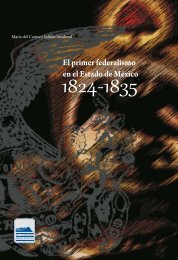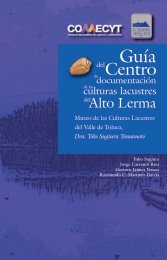Create successful ePaper yourself
Turn your PDF publications into a flip-book with our unique Google optimized e-Paper software.
ERIC VAN YOUNG, THE SPHYNX OF SAN COSME: A HISTORIAN’S THOUGHTS ON WRITING A BIOGRAPHY<br />
tions of the Mexican Catholic Church? They had<br />
been estranged due to intra-family conflicts over<br />
inheritance issues, though after a rapprochement<br />
while Lucas was still an adolescent they<br />
became close for the last decades of the churchman’s<br />
life—but what was the nature of the reconciliation<br />
and of the relationship the two developed?<br />
(Alamán, 1968; Arechederreta, 1927) 7<br />
How did he feel about his own father, the Spanish<br />
immigrant miner, mining financier (aviador),<br />
and merchant Juan Vicente Alamán (1747-1808),<br />
barely mentioned in his son’s uncompleted and<br />
unpublished memorias of 1833 or his other writings,<br />
except to be described as a hard worker?<br />
His mother María Ignacia Escalada de Alamán,<br />
by contrast, was unambiguously praised by<br />
her son as one of the most beautiful women<br />
ever seen in Guanajuato, appears frequently in<br />
his autobiographical account, and was to play<br />
a major role in his life well into his maturity.<br />
What were Lucas Alamán’s intimate thoughts<br />
and feelings about his religion? We know he<br />
was personally very pious and observant, as a<br />
young man joined the Third Order of Saint Francis<br />
(and must therefore have been interred in<br />
Franciscan habit at his death in 1853), was an<br />
ardent supporter of the Church politically, and<br />
believed it was the only social bond that held<br />
Mexicans together at a time when the claims of<br />
the “imagined community” were still very weak<br />
among them (Anderson, 2006). When the large<br />
Alamán family lived on the Ribera de San Cosme<br />
did don Lucas stroll contemplatively in the vast<br />
gardens and orchard of the property? We may<br />
suppose so but do not know. And although we<br />
know that he wrote standing at a desk (because<br />
Guillermo Prieto tells us so), what hours did he<br />
keep as he composed his monumental Historia<br />
de Méjico in the final years of his life, and what<br />
were his other work habits? (Prieto, 1906). What<br />
were his feelings about the three major lessthan-successful<br />
private entrepreneurial projects<br />
that in his last years came to shadow him with a<br />
large debt overhang, and at his death in 1853 left<br />
him a poorer man than he had been at the age<br />
of fifty or so? These included his involvement<br />
with British mining investments in Mexico in the<br />
7 Alamán leaned heavily in writing his Historia de Méjico on<br />
his elder brother’s unpublished notebooks chronicling events<br />
of the 18<strong>10</strong> insurrection in a very anodyne, schematic way,<br />
which Alamán nonetheless found extremely valuable and<br />
praised for their author’s objectivity.<br />
1820s, his purchase and later sale of a hacienda<br />
in the Celaya region of which his hopes for it as<br />
an income-producing property had been hugely<br />
disappointed, and the resounding failure of an<br />
enormous textile enterprise he managed in the<br />
Orizaba area in the late 1830s and early 1840s.<br />
We may suppose these failures provoked disappointment<br />
in him, disillusion, or even bitterness;<br />
he offers hints about this but never any revealing<br />
insights as to his thinking.<br />
The object of this essay is not to provide a<br />
thumbnail biography of the great statesmanhistorian,<br />
and still less to answer the questions I<br />
have just posed or a host of others that might be<br />
asked, but to use the two decades of research<br />
I have done on his life to discuss some general<br />
questions about the writing of biography while<br />
offering some reflections on my own experience<br />
as a historian (temporarily) turned biographer.<br />
Why Biography?<br />
Why do we write biographies, anyway, and why<br />
do people read them? One reason among many<br />
is simple curiosity about the lives of the famous<br />
and infamous. A biography can be like a good<br />
detective story, and while an interest in the<br />
details of someone else’s life is not necessarily<br />
morbid, we do love the gossipy aspects. Especially<br />
if we already know the general shape of<br />
the life-course, we hope to experience the frisson<br />
of revelation and surprise at points of inflection<br />
in the narrative. Then there is the inherent<br />
interest that some people hold: great geniuses,<br />
great heroes, or great villains whose stories are<br />
told again and again. Did we really need a halfdozen<br />
or so biographies of Lawrence of Arabia<br />
to be convinced of his intelligence, bravery, and<br />
tortured personality, or yet another of Leonardo<br />
da Vinci to acknowledge his genius?; apparently<br />
so. Biographies also help us to make sense of<br />
our own lives as we follow a more or less organized<br />
narrative through the life stages we may<br />
not be able clearly to discern in ourselves, giving<br />
us names for them and comparative metrics by<br />
which to judge our own advance, accomplishment,<br />
or failings. Yet another reason for writing<br />
and reading biography lies in its instrumental<br />
value: the life story of some extraordinary human<br />
being, or of an ordinary person in extraordinary<br />
circumstances, may reveal how things got<br />
4


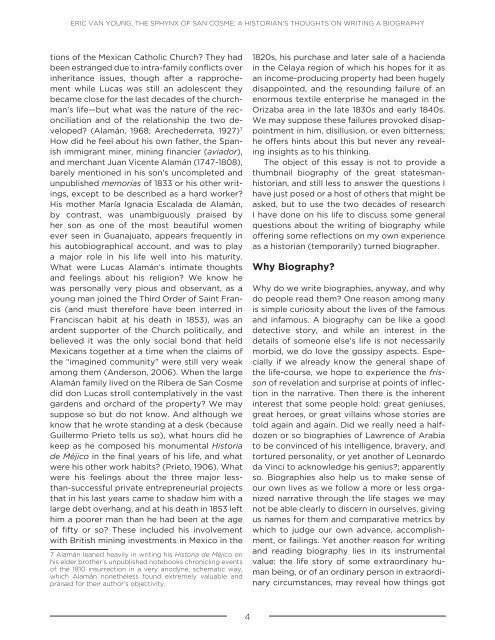
![bicentenario_1[V2]](https://img.yumpu.com/68677971/1/167x260/bicentenario-1v2.jpg?quality=85)
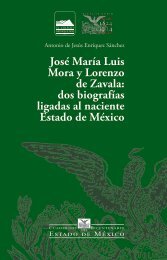
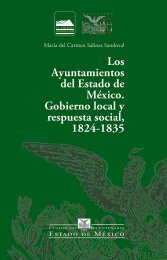

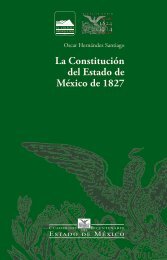
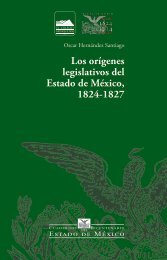
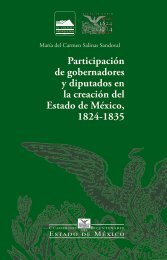
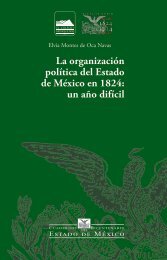
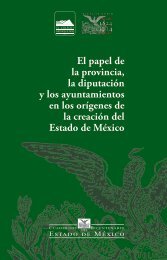
![El_primer_federalismoEM[final]_compressed (2)](https://img.yumpu.com/68483279/1/178x260/el-primer-federalismoemfinal-compressed-2.jpg?quality=85)
